Perhaps you’d be knew that Icebergs are
formed when large blocks of ice breaks off from glaciers ice shelf and is
floating in open water. Icebergs are born as elegant ancient glaciers
rumble, crack and calve, and comes in all shapes and sizes, from tiny growlers
which are approximately size of small cars, to bergy bits which size are of a
small house, to massive icebergs of all sizes. Though icebergs can be striped
and come in numerous colors that are revealed as the iceberg “rolls” over in
the sea, the water from bergs is very pure since the ice formed long ago.
Nearly 70% of all fresh water is locked in the polar ice caps. Just the new icebergs
that form every year around Antarctica hold enough water to meet the needs of
every person on Earth for several months.
Generally glaciers are built up from
snow falling on the Antarctic continent over millennia; this ice consists of
pure fresh water. This floating chunk of freshwater ice then interacts with
seawater beneath them it. As seawater is drawn deep under the ice shelves by
the oceanic currents, it becomes super-cooled and freezes to the base of the
ice shelf. The ice is formed from seawater that encompasses organic matter and
minerals it causes variety of color and texture to the iceberg. When the bergs
become fragmented and sculpted by the wind and waves, the various colored
layers develop striking patterns. Striped icebergs in a various colors,
including black, yellow, brown, and blue has been spotted in freezing waters
around Antarctica.
Usually an iceberg looks white as a
result of the tiny bubbles trapped within which scatter light in every
direction. Blue stripes are formed when a crevice in the ice sheet fills up
with melt water and freezes so rapidly that no bubbles form. Ice that is bubble
free has a blue tint which is due to the same light marvel that tints the sky
the wavelength of blue light causes it to be scattered or spread around much
more than the other colors. When an iceberg falls into the sea, a layer of
salty seawater can freeze to the base. If this is abundant in algae, it can shape
in green stripe. However; other hues such as black, yellow and brown, are produced
by sediment, picked up when the ice sheet grinds downhill towards the sea.


























+located+between+Hulopoe+Bay+and+Manele+Bay,+in+Lanai,+Hawaii.jpg)


